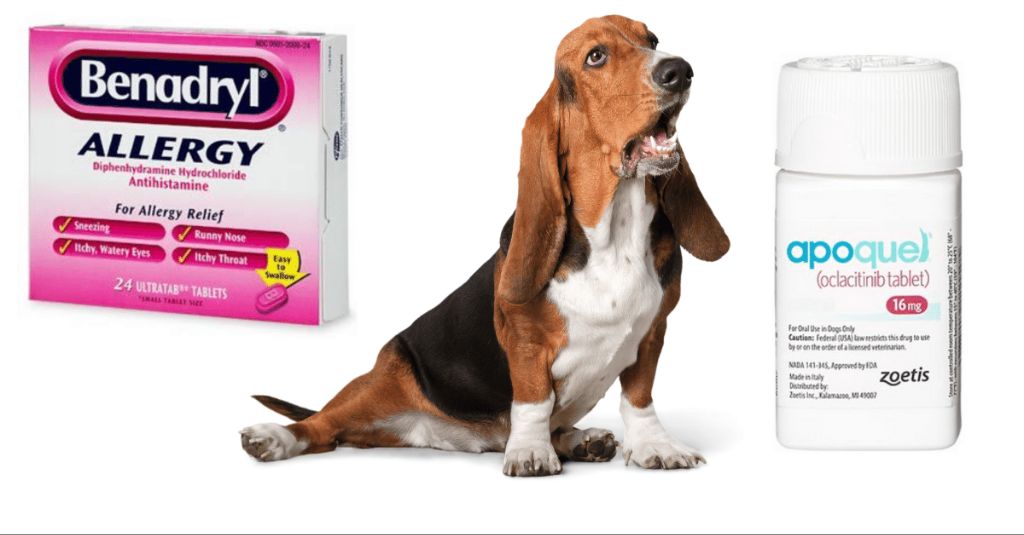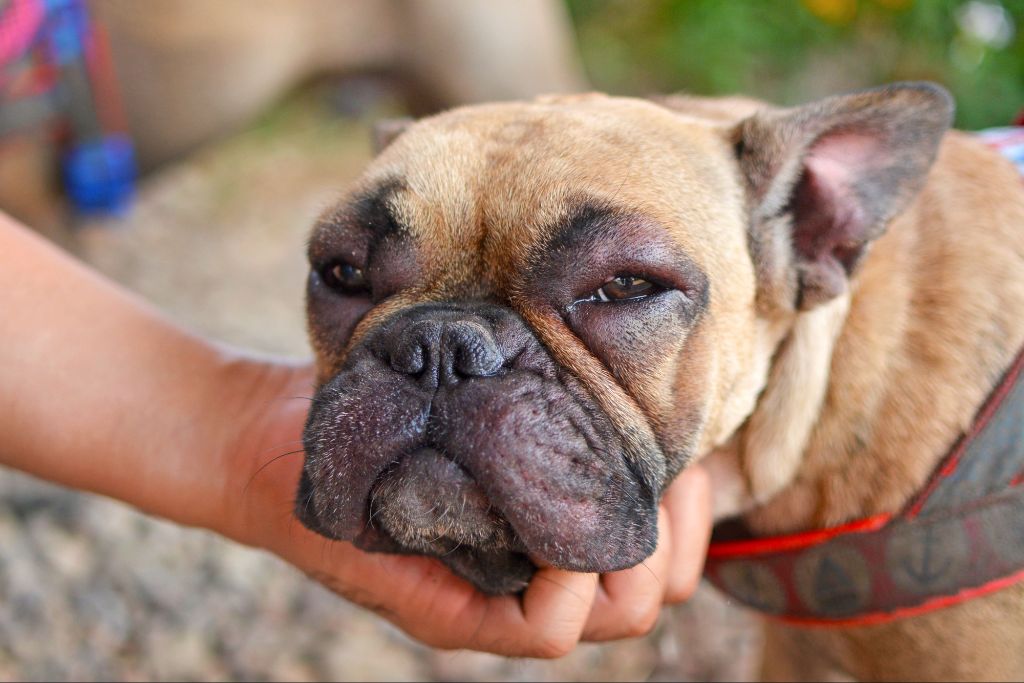Introduction
Pet owners often look for ways to save money on veterinary care. According to a survey conducted by The People’s Dispensary for Sick Animals, over one-third of pet owners have given their animals human medications instead of paying for veterinary treatment (https://www.mirror.co.uk/news/uk-news/14million-pet-owners-given-animals-7517085). This concerning trend highlights the need for education on proper dosage and effects when using human medicines like Benadryl in dogs.
What is Benadryl?
Benadryl is a brand name for the drug diphenhydramine hydrochloride. Diphenhydramine is an antihistamine that blocks the effects of histamine, a chemical in the body that causes allergy symptoms. By blocking histamine, Benadryl helps to relieve symptoms of hay fever, other upper respiratory allergies, and allergic reactions to food, insect stings, and certain medicines [1].

In humans, Benadryl is used to treat symptoms of allergies and colds such as:
- Runny nose
- Sneezing
- Itchy, watery eyes
- Itching of the nose or throat
Benadryl is available in tablets, capsules, meltaways, liquid gels, creams, and injectable formulations [2].
Benadryl Uses in Dogs
Benadryl is commonly used in dogs for treating allergies, motion sickness, and as a mild sedative. Its active ingredient, diphenhydramine, blocks histamine receptors and helps relieve allergy symptoms like itchy skin, runny eyes, sneezing, and skin irritation [1].
For allergies, Benadryl can provide fast temporary relief when dogs experience reactions to food ingredients, medications, vaccines, household chemicals, pollen, dust mites, and other common environmental allergens. It reduces inflammation, itching, and swelling. Benadryl is often used to manage acute flare-ups of chronic allergic reactions [2].
Benadryl is also effective at preventing and treating motion sickness in dogs. The drowsiness side effect can help calm anxious dogs prone to nausea and vomiting during travel. It can be given 30-60 minutes prior to the start of a car ride or plane trip [1].
In addition, Benadryl’s sedative effects make it useful as a mild sleep aid for dogs with anxiety or restlessness at night. The optimal dose for this purpose is 1-2 mg per pound given 30 minutes before bedtime [2].
Benadryl for Dog Swelling
Benadryl contains the active ingredient diphenhydramine, which is an antihistamine. Antihistamines work by blocking the release of histamine in the body, which is responsible for many allergy symptoms including swelling. By preventing histamine from binding to receptors, Benadryl can reduce inflammation and swelling in dogs from allergic reactions or insect bites and stings (https://www.akc.org/expert-advice/health/benadryl-for-dogs/).

In addition to allergies, vets may prescribe Benadryl for dogs with mast cell tumors, which can cause swelling when the tumors release histamine. Benadryl helps control this swelling. It may also be used short-term for swelling and itching from skin issues like hot spots. However, it’s important to identify and treat the underlying cause of skin problems rather than just managing the symptoms (https://www.petmd.com/dog/care/can-i-give-my-dog-benadryl-and-if-so-how-much).
While Benadryl can temporarily reduce swelling in dogs, it’s not a cure. Swelling often indicates an underlying health issue that requires diagnosis and treatment from a vet. Benadryl should not be used long-term or in place of veterinary care.
Proper Benadryl Dosage for Dogs
The proper dosage of Benadryl for dogs depends on several factors including the dog’s weight and health condition.
The standard starting dose is 1 mg of Benadryl per pound of the dog’s body weight, given 2-3 times daily. For example, a 20 pound dog would start with a dose of 20 mg. This dosage can be adjusted up or down as needed, under veterinary guidance.
Some vets recommend giving 2 mg per pound for dogs with more severe allergies or itching. However, the maximum total daily dose should not exceed 2-4 mg per pound.
For example, a 50 pound dog should not get more than 100-200 mg total in a 24 hour period. Exceeding the maximum safe dose can result in sedation, agitation, increased heart rate, and other side effects.
It’s important to accurately measure your dog’s weight and administer Benadryl carefully to avoid overdosing. Consult your veterinarian if you are unsure of the proper dose for your dog’s size and condition.
Sources:
https://www.petmd.com/dog/care/can-i-give-my-dog-benadryl-and-if-so-how-much
https://www.omnicalculator.com/biology/benadryl-dosage-for-dogs
Benadryl Side Effects in Dogs
While Benadryl can help with allergies and other conditions in dogs, it does come with some potential side effects that pet owners should be aware of. Some of the most common side effects seen with Benadryl use in dogs include:

Sedation
One of the most common side effects of Benadryl in dogs is sedation or drowsiness. The antihistamine effects of diphenhydramine, the active ingredient in Benadryl, can have a tranquilizing effect and make dogs very sleepy. This effect is usually mild, but some dogs can experience extreme lethargy or lack of coordination after being given Benadryl. It’s important to monitor your dog after administering Benadryl to ensure the sedation is not too severe.
Dry Mouth
Benadryl has anticholinergic properties which can reduce saliva production and cause dry mouth in dogs. You may notice your dog seeking out more water or panting excessively. Dry mouth can also lead to vomiting, so make sure your dog has access to plenty of fresh water after taking Benadryl.
Potential Drug Interactions
Benadryl should be used cautiously in dogs taking other medications, especially other drugs with anticholinergic effects like some behavioral medications, antihistamines, and muscle relaxants. Using Benadryl together with these drugs can increase side effects like dry mouth, urinary retention, vomiting, and lethargy. Always talk to your vet before using Benadryl if your dog takes any other medications.[1]
[1] https://vcahospitals.com/know-your-pet/diphenhydramine
When to Avoid Benadryl in Dogs
Benadryl is generally safe for use in most dogs. However, there are some situations in which you should avoid giving Benadryl to your dog.
Puppies and young dogs typically should not be given Benadryl, as they may have adverse reactions. Benadryl can cause sedation and lethargy. Since puppies are still developing, Benadryl could potentially affect their growth. Always consult your veterinarian before giving any medication, including Benadryl, to puppies.
Dogs with underlying health conditions may also not be good candidates for Benadryl. Benadryl can potentially interact with other medications your dog is taking. It can also exacerbate certain medical conditions like glaucoma, heart conditions, high blood pressure, and seizures. If your dog has any pre-existing conditions, talk to your vet before using Benadryl.
In general, avoid giving Benadryl to pregnant or nursing dogs. The effects it may have on developing puppies is unknown. An exception could be made if your vet recommends Benadryl for a specific purpose.
If your dog has reacted poorly to antihistamines like Benadryl in the past, do not administer it again without veterinary guidance. Some dogs may be sensitive or allergic to ingredients in Benadryl.
Always consult your vet before giving your dog any new medication, especially if they have underlying medical issues or are very young. Your vet can help you determine if Benadryl is appropriate and safe for your dog.
Alternatives to Benadryl
While Benadryl is commonly used for allergies and itching in dogs, there are some other options dog owners can consider:

Other over-the-counter antihistamines like cetirizine (Zyrtec®) and loratadine (Claritin®) can help relieve allergy symptoms. According to the AKC, these OTC antihistamines are generally safe for dogs when used according to label directions1. However, it’s best to consult your veterinarian before giving any medication.
Prescription anti-inflammatory drugs may also help reduce allergy symptoms and swelling. Your vet may prescribe steroids like prednisone or non-steroidal anti-inflammatory drugs (NSAIDs) like meloxicam. These medications can be very effective, but should only be given under veterinary supervision due to potential side effects.
There are also some natural supplements that may help soothe allergies, such as quercetin, omega-3 fatty acids, and bromelain. Talk to your vet before giving any new supplement.
When to See the Vet:
In some cases, facial swelling in dogs can be severe and require immediate veterinary attention. According to Pekin Veterinary Clinic, you should take your dog to the vet right away if their face is extremely swollen or they are having trouble breathing. Signs of a severe allergic reaction or anaphylaxis include swollen eyelids, lips, and tongue, drooling, vomiting, and collapse. Quick veterinary care is crucial in these emergency situations.
You should also take your dog into the vet if the facial swelling does not start to improve within 24 hours of taking Benadryl or implementing other home treatment. As noted by Veterinary Medical and Surgical Group, persistent facial swelling could indicate an underlying infection or condition requiring medication or other veterinary treatment. It’s important not to delay seeking professional veterinary attention if the swelling gets worse or does not subside with initial treatment at home.
Severe allergic reactions and facial swelling that does not improve both warrant immediate veterinary care. Consulting with a vet is advised to provide proper treatment and identify any underlying issues causing persistent dog facial swelling.
Conclusion
To summarize, Benadryl can be used to reduce swelling in dogs when used appropriately and under the guidance of a veterinarian. The antihistamine and anti-inflammatory properties of diphenhydramine, the active ingredient in Benadryl, makes it effective at reducing inflammation, redness, and swelling. However, proper dosage based on your dog’s weight is crucial, as Benadryl can have side effects like sedation. Your vet can advise you on the correct dose to give your dog safely.
In most cases, Benadryl should not be used long-term or as a substitute for veterinary treatment. It’s important to identify and address the underlying cause of your dog’s swelling. Mild swelling from insect bites or minor injuries can be alleviated with short-term Benadryl use, but more serious conditions require medical intervention. Contact your vet if the swelling persists, worsens, or is accompanied by other symptoms.
When used responsibly under veterinary supervision, Benadryl can provide temporary relief of swelling in dogs. But dog owners should be aware of proper dosage, potential side effects, and alternatives before giving their dog antihistamines. Monitoring your dog closely and working with your vet is key to ensuring their health and safety.